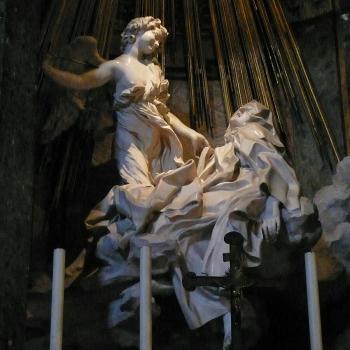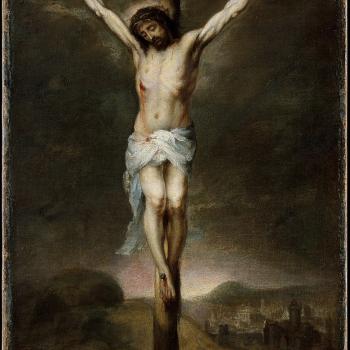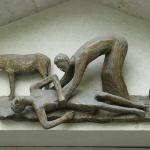On Friday night I went over to Libresco‘s to talk about “the Benedict Option” with a group of mostly-Christians. (“Mostly Christian is partly pagan!” —Miracle Max describes all of us, sometimes.) It was a wide-ranging discussion so I’m not giving you just one summary post but a short series on how deracinated, distracted, economically and vocationally and psychologically unstable cosmopolites (God bless us, every one) can create spaces where Christ is easier to see.
First, what is the thing? “Benedict Option” is a term coined by Rod Dreher and meaning Rod-knows-what, but in our discussion I think it covered three different approaches: three points on a spectrum, or three frameworks for articulating what we’re looking for. Do all these things need names, and if so, do they need the same name? Maybe not; but all three things are about creating thicker Christian community life, and getting out of our own heads. (Out of our heads, and into the streets!)
Leah’s post on “Accidental Stylites” gives the most individual-centered account of what a “Benedict Option” might be:
Rod Dreher is the biggest promoter of the idea, which takes its name from the Benedictine monasteries that acted as centers of Christian faith, both for the monks that lived within them and (more relevantly for me!) the lay communities that sprang up in the shadow of the monasteries. These ordinary people had the chance to be nourished by the monks while remaining more entangled with the rest of the world.
At my discussion group this weekend, we’re going to try to stay focused on the practical (as Noah Millman wishes), thinking about changes we might make or projects we could start in the next six to twelve months that could help us support each other more, live our faith exuberantly, and, basically, extend the feeling I’ve had at some Dominican-run events, “spaces where joyful piety happens to you more often; a few spaces where your Catholicism doesn’t feel like an act of resistance, any more than eating does.”
This is a definition that’s portable–you can seek out spaces like this in your next home, if you move–and it’s focused on changing the individual’s experience of faith and of participation in the Body of Christ.
But one of the people at her get-together said that the Christian life, as she’s experienced it, is “so beautiful–and it’s so fragmented. Or it can be.” Two other ways of understanding the “Benedict Option” focus more on embedding people into a sort of mosaic, a pattern that sticks together. These two possibilities require much more willingness to stay in one place, and therefore have more severe economic consequences. On the other hand, they’re more enveloping, and they offer a more thorough transformation of your life, if that’s something you’re looking for.
The middle point on the spectrum is an approach you could call vocation-centered, since there are parallels with the vocation-centered vs. church-centered approaches I sketched out here. But I think it makes more sense to call this second possibility “homemaking.”
Homemaking is about creating a small community: the people you come home to, basically. It’s about the “domestic church” of the family–including, importantly, your chosen family, the friends who have become your kin.
And the third approach sticks most closely, in my opinion, to what Alisdair MacIntyre was doing when he invoked St. Benedict in the first place, in After Virtue. Benedict stands, in this argument, for the idea that community shapes ethos. We are unintelligible to one another–we can’t even “achieve disagreement” in political or cultural debate–because we have no shared ethos, and we have no shared ethos because we have no real communities. We’re formed by economic pressures, entertainment, and consumerism; we conflate “good” and “likely to produce economic success”; even the advice we give about marriage and family takes economic stability as the highest moral good, and since global capitalism acts as an acid corroding community, pursuing economic stability will very frequently require severing personal ties and commitments. Yet it is from these personal bonds that a coherent Christian ethos and/or way of life could emerge. So the third way of looking at the “Benedict Option” is that it’s about creating actual communities, in actual places, which make a Christian way of life not only plausible but vivid: more real than the Internet, you know? Havens where your Christian life isn’t about what you do on Sundays with strangers, but about what you do every day with neighbors.
I believe that community creates ethos, in part because I think I’ve experienced at least one ethos-forming community (my college debating society), and it was an intense, overwhelming experience. It was sort of ecstatic, spending four years enraptured by a tradition-adorned, rabidly Socratic community. It taught me how to live with tensions and paradoxes–real communities always teach you this, read the Desert Fathers–and it taught me what it felt like to live every day within a purpose. I’m not saying I acted well, or even that I acted well-according-to-the-ethos-of-the-group. I “sinned” pretty much daily, if not hourly, against the group’s ethos of brotherhood and radical pursuit of truth. But I lived within that ethos. Imagine if your life felt teleological all the time, and this telos, tantalizingly out of reach, filled you with awe.
My Catholic life, I’m sorry to say, only reaches that ecstasy intermittently. (I’m also, you know, not constantly drunk and 19, so there’s that.) I don’t think a “Benedict Option” community can or should have that overwhelming intensity. We used to joke that our debating society was “a cult, sure–but it’s a cult of the Good!” You can kind of get away with that in college, although whether we actually lived out our cultishness without hurting too many people too badly is debatable. But a real community that people really live in, which they share with their parents and with the people they rely on for the sacraments and for emotional support–that can get cult-of-the-Bad real fast.
So the idea of creating a communal haven, a little city of souls, is simultaneously the most radical and (therefore, I guess) the most dangerous version of the Benedict Option.
This group at Leah’s place seemed really aware of the ways small purposeful communities can go wrong. We didn’t end up doing any explicit discussion of problems or dangers, but many of them came up implicitly in other ways during the conversation because they were things some of us were interested in anyway. For example, several people expressed interest in mutual support for abuse survivors, including people abused in the name of religion or within religious communities. It can be depressingly hard to find explicitly-Christian communities or mutual support in that area where you won’t be shamed, bullied into forgiveness-without-justice, etc. This was a group with a lot of, let’s say, not-straight members; a group with a surprising number of converts from Judaism (or Jewish ethnicity, which I guess is different); and a group with several people who had been hurt by, or whose friends had been hurt by, “Fortress Catholicism”-type communities based on fear of the outside world. Plus another demographic quirk that I’ll discuss separately because it fascinated me. Anyway I think the specifics of the group made the conversation feel fearless and exuberant, rather than fearful of either Decadent America or the culty little weaponized churches formed in opposition to decadence. Which means you, the reader, don’t need to be motivated by fear of either of those things as you explore “the Benedict Option.”
Ok, this post is already super long. Next up: Semi-practical things! (Boo, hiss.)











